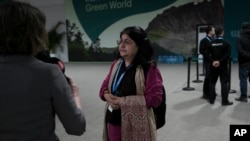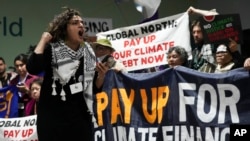Anger and frustration from developing nations vulnerable to climate impacts are likely to linger following the conclusion of the climate change summit in Azerbaijan, COP29, as nations adopted a $300 billion global finance target to help poorer nations cope with climate change, a deal that many recipient nations slammed as severely insufficient.
Global North countries, often historic emitters responsible for global warming, agreed on Sunday to pledge $300 billion a year until 2035 for their developing counterparts to stave off the direst effects of climate change — less than a quarter of the acknowledged $1.3 trillion needed annually to reduce emissions and build resilience in vulnerable countries.
The $300 billion figure, also, is an increase by $200 billion each year, compared to the agreement in place since 2009, which is expiring.
Spirited disappointment and rage from Global South countries was expressed at the closing plenary, with some national representatives calling adoption of the new funding package “insulting.”
“We are extremely disappointed,” said Indian negotiator Chandni Raina, who called the figure “abysmal.”
Her Cuban counterpart, Pedro Luis Pedroso, described the deal as “environmental colonialism,” pointing out that, when factoring in today’s inflation, the pledged funding is lower than the $100 billion agreed to in 2009. Bolivia’s negotiator called the deal “insulting” to developing nations.
Some Western representatives were more upbeat.
“COP29 will be remembered as a new era of climate finance,” top EU climate negotiator Wopke Hoekstra said, calling the target amount “ambitious” and “achievable.”
Some experts told VOA that the structure and composition of the $300 billion deal was more important than the actual monetary figure. The final deal allows for both public and private sources of funds to be tapped to bolster climate preparation efforts in the developing world.
Negotiators for developing countries expressed concern that private sources of funding could come in the form of more loans, which could lead to challenging debt accumulation by poorer nations, rather than funding in the preferred form of grants.
Global South countries argued for a new target for green finance and have consistently called for such climate finance to come in the form of public grants. The tense and fraught negotiations of the past week dragged on for two extra days and included at least one episode of negotiators from small island nations and some of the poorest nations in the world walking out of a meeting room with wealthy nations in protest. They asserted that their voices and perspectives were not heard.
”This COP has been a disaster for the developing world,” said Mohammed Adow, director of Kenya-based climate and energy research group Power Shift Africa. ”It’s a betrayal of both people and planet, by wealthy countries, who claim to take climate change seriously.”
The adopted finance package also stated that a further roadmap is set to be discussed at the next conference – likely COP30, set for Belem, Brazil in late 2025 — on how to reach the trillion-dollar figure.
Independent South African climate consultant Gillian Hamilton called the $300 billion core funding target “insufficient,” particularly for building resilience against climate impacts — also known as climate adaptation.
“Developed nations should have shown more leadership and transparency,” Hamilton told VOA. “The biggest emitters need to rapidly decrease their emissions so that adaptation costs for developing countries don’t increase exponentially.”
Campaigners staged multiple environmental protests each day here during the past week-plus of meetings.
Though negotiators for developing nations repeatedly asked for climate finance in the form of grants instead of loans, in the final deal, developed countries stopped short of guaranteeing that could be done.
Adaptation finance
The deal adopted Sunday acknowledges that funding sources for adaptation finance should be public and transparent.
With 2024 going down as the hottest year in history, the world has experienced a slew of climate disasters, ranging from devastating floods in Nepal and Spain, to Hurricane Helene in the Americas, droughts in the Mediterranean and typhoons in the western Pacific region.
Despite the disasters and renewed calls to finance climate-resilient infrastructure across the Global South to guard against rising sea levels and wildfires, funding has been falling short for years, according to a November report from the U.N. Environment Program.
The so-called adaptation projects include developing more advanced disaster warning systems, reforestation, and building catchment mechanisms to ensure water security in regions most affected by climate change.
At COP29, Germany pledged $62 billion, to the adaptation fund; France highlighted its 2023 pledge of $2.9 billion, in adaptation; the U.S. said it pays $3 billion into it each year. A total of 14 Global North countries including Spain, Sweden, South Korea and Switzerland promised to provide $300 million this year, according to a separate negotiation text in the conference.
Despite pledges in recent years, countries didn’t completely deliver on promises. This year, for example, more than $122 million of pledged financial support to poor nations for adapting to climate risk is still up in the air, even though this assistance has been a stated priority at recent COP meetings.
What to expect in Belem?
Countries will be tasked at the Brazil meeting next November with ironing out the details of a global carbon trade system governed by a centralized U.N. regulatory body. They also will try to find a path for wealthy, developed countries to reach the target of $1.3 trillion to support efforts in the Global South to address the consequences of climate disasters. A major component will be reviewing national climate plans, which are due to be submitted in February. Britain, Brazil and the UAE are among the nations that this past week aimed to get ahead of the February deadline and shared some of the goals in their national climate preparation plans.
Harjeet Singh, global engagement director of the Fossil Fuel Non-Proliferation Treaty, said it is likely that ‘most’ nations will not meet the February deadline to submit their updated plans to address climate change.
The future participation of Argentina is unclear, after hardline President Javier Milei — who has called climate change a hoax — reportedly told his government delegates here to pack their bags and leave the negotiations on the third day of the summit.
Singh was asked by VOA whether wealthy nations would deliver on their promises to lead the effort toward $300 billion in climate finance support, and he responded that the key lies in their ‘willingness, as the money has always been there.’











